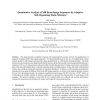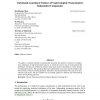166 search results - page 7 / 34 » On Learning Mixtures of Heavy-Tailed Distributions |
VLSISP
1998
13 years 8 months ago
1998
This paper presents an adaptive structure self-organizing finite mixture network for quantification of magnetic resonance (MR) brain image sequences. We present justification fo...
ECCV
2004
Springer
14 years 10 months ago
2004
Springer
The problem of tracking a varying number of non-rigid objects has two major difficulties. First, the observation models and target distributions can be highly non-linear and non-Ga...
ECSQARU
2009
Springer
14 years 3 months ago
2009
Springer
We describe a procedure for inducing conditional densities within the mixtures of truncated exponentials (MTE) framework. We analyse possible conditional MTE specifications and pr...
JMLR
2002
13 years 8 months ago
2002
We apply a variational method to automatically determine the number of mixtures of independent components in high-dimensional datasets, in which the sources may be nonsymmetricall...
ICML
2007
IEEE
14 years 9 months ago
2007
IEEE
The four-level pachinko allocation model (PAM) (Li & McCallum, 2006) represents correlations among topics using a DAG structure. It does not, however, represent a nested hiera...


